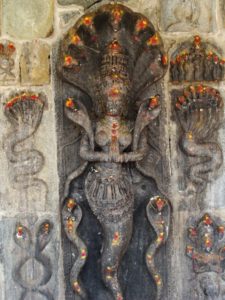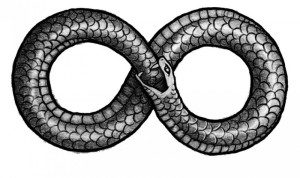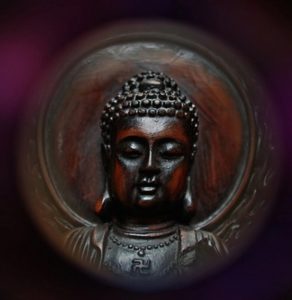Vasuki: You’ve been aware of Naga-Gnosis for quite some time.
Vajragoni: How did I come to this Gnosis?
Vasuki: By continually shedding your old skin, so to speak. Coming out of your habits and associations into a transmuted being. You have to realize that although human in form, you are quite something other in spirit in your ongoing transformation.
Vajragoni: I’m intrigued.
Vasuki: The spirit of a Naga is its naked awareness—this is its naked truth, being empowered and ennobled to rise above mere human consciousness into the unbounded and deathless freedom of the Unborn. The key to do this is by crossing the threshold from the tempo of the Bardo-realms to final Dharmakayic Realization—the ultimate ecstasy. The Nagas are the guardians of this threshold; once they recognize you as a kindred spirit, the door to these transcendent treasures is opened.
Vajragoni: How does one maintain this intercourse with the Nagaic-Mind?
Vasuki: Your own inner Yin-Dragon is the agent that sustains this symbiosis.
Vajragoni: What do you mean by this “inner Yin-Dragon”?
Vasuki: Since the earliest origins of the human agency, the ancient Nagas have implanted the capacity of being nurtured by the Yin—THAT primordial Dark Energy that actually sustains the entire cosmos. Without the Yin to support and nurture it, the outer mechanism of the fiery Yang element eventually burns itself out. The inner Yin-Dragon factor provides the balance. It is the very lifeblood of the Primordials themselves.
Vajragoni: Are you saying, then, that this Dragon-Blood sustains my own spirit?
Vasuki: Without it you would surely shrivel-up in the face of outer adversity and inner-turmoil as stirred up by the evil one. In this sense the Nagas are protectors, not only of the Sacred Buddhadharma, but of the very integrity of your own mind and spirit.
Vajragoni: How does the Lanka-factor come into play with all this? I mean, does the sutra have elements that explain what you are portraying?
Vasuki: The Lankavatara Sutra was originally chronicled by the Nagas, i.e., the Nagan scribes recorded what transpired between the Buddha and his early discourse with Ravana as well as the later and more extended exchanges between the Blessed One and Mahamati the Bodhisattva-Mahasattva.
Vajragoni: Many scholars contend that the Lanka was a Yogacara creation.
Vasuki: They are only partially correct. The Yogacarins later refined many of the Mind-only principles, in particular with a nuance on the Alaya-receptacle, but the cittamatra constructions were originally entrusted to the Nagas by the Buddha for safe-keeping before they were finely articulated in the framework of the Lanka. For instance, the renowned “turn-about” in the deepest recesses of consciousness is a Nagan-technique of stretching Mind’s inner-reserves back upon Itself in order to refresh the inner-realization that IT must remain prior to IT’s phenomenal outflows.
Vajragoni: Fascinating! Curious, does the symbol of the Ouroboros in any way represent this primordial triggering effect?
Vasuki: Indeed it does. If you were to turn it-round you would see that it resembles the shape of a figure-eight on its side, which represents infinity:
In other words, Mind must continually turn-back upon Itself to keep the tail of phenomena in check. Recollect, Zen folk would describe it as the Hua-t’ou remaining prior (anteceding) to and consuming the Hua-Wei (the tail) and not the other way around.
Vajragoni: What other Lankavatarian principles did the Nagas disclose?
Vasuki: They can be aligned in the following formulation:
Mind Only: All of phenomenal-outflows are non-other than projections of Mind Itself.
The Tathagata-garbha: the very womb of Buddha-potential, housing the Dharma-seed that, with the right spiritual cultivation, matures into the full-blossoming of the Bodhi-Mind, or becoming as One with the mindstream of the Tathagatas.
Trikāya, or the three bodies of the Buddha: the Truth or Transcendent Body (Dharmakaya); the Enjoyment Body (Sambhogakaya) wherein Buddhas and their teachings are revealed in profound Mystical bodies and settings; and the concretized emanations of a Buddha’s formalized manifestation (Nirmanakaya) in order to directly attend to the state of sentient affairs.
The Sunyata Doctrine: all sensate substrata are Self-Empty, meaning that they are dependently originated and have no Absolute existence in and of themselves.
The subtle nature of the Unborn principle: “O Mahamati, it is taught by the Tathagatas of the past, future, and present that all things are unborn. Why? All things are unborn because they are the manifestations of our own mind and have no reality of their own.” Authentic Buddhahood is ultimately an imageless affair.
The Self-Stature of the Tathagatas: throughout the Lanka the Tathagatas are presented as perfected Bodhi-Beings that have mastered the art of Mind-Liberation and spontaneous Illumination, not only for themselves, but for all struggling sentitalia.
Vajragoni: I’m also reminded of the svastika that appears on the breast of the Tathagata having a dominant position in the opening chapter of the Lanka—is it also Naga-related?
Vasuki: It is a sign of the Naga itself—exhibiting the principle of harmonious cohesion or a balanced-interplay between the Body, Heart, Mind, and Spirit:
Vajragoni: Why is this sign so prominently placed on the breast of the Tathagata?
Vasuki: It indicates that the Buddha was once himself a Naga, taking rebirth in the Naga-realm before his last incarnation and gaining access to much secret wisdom. Not only that, but that Nagas (entrusted as they are to the Buddhadharma) can only be taught by Buddhas who were once Nagas themselves. Thus the Tathagata is always known as a Maha-Naga.
Also know that Maitreya himself currently sits in the Tushita Heaven beneath a Naga-tree and is earnestly attentive to his Naga instructors preparing him for his final Enlightenment when he shall descend into the saha realm and, like Shakyamuni before him, will sit below a Bodhi Tree that is always guarded by a Maha-Naga, like Muchilinda.
Vajragoni: (bowing) Thank-you! There is much to contemplate.
Vasuki: May the Blessings of the Maha Nagas remain with you always.






Did this occur in dhyana? Interesting encounter, if it is indeed your experience.
Do any of the scriptures actually recommend Naga birth, though, as a ‘step’ on the journey to the Great Liberation? I thought human birth (not necessarily confined to this present world) is deemed the superior option of all samsaric beings.
This Sir Vasuki seems to have quite the naga-centric perspective (extolling it above ‘mere human’ and so on), but just because a naga lord tends to have a bias towards a certain ‘naga-centrism’, if one may so express it, doesn’t mean it is truer than ‘anthropocentrism’.
I intend no disrespect towards the nagas, by the way. To the extent that they protect and honour the Dharma, I am their friend. In the Islamic tradition it is said that from amongst even one single nation of ‘jinn’ (non-human spirits) there may be some that are Muslim and others that are unbelievers. It might have been interesting if you asked whence comes the sinister reputation of some nagas in India, and the demonic and ‘fallen-angelic’ connotations attached to the symbol of the serpent and/or dragon in traditions farther west.
In Tibetan Buddhism the naga seems to be virtually absent, at least in a positive and on-going/living revelatory and protective function (while it continued, of course, to be recorded in the Indian canon). Gnostic revelations came in general by way of the dakini, the feminine powers central to Vajrayana that also were transformed into something quite different from the sinister witch-spirits originally associated with the name in pre-Buddhist popular traditions.
You raise some interesting, although not an altogether truistic understanding concerning the import of the Nagas. They’ve always held a prominent place in the sutra-tradition, and I dare say a most prominent role as “protectors” of the Buddhadharma. Also, remember that Buddha-nature is never discriminatory but uninhibitedly all-encompassing. Witness the Chapter in the Lotus Sutra in which the Great Manjushri himself rises from the naga-palace at the bottom of the sea and imparts the wonderful story of the Naga-Kings daughter:
“There is the daughter of the nāga king Sāgara who is only eight years old. She is wise; her faculties are sharp; and she also well knows all the faculties and deeds of sentient beings. She has attained the power of recollection. She preserves all the profound secret treasures taught by the buddhas, enters deep meditation, and is well capable of discerning all dharmas. She instantly produced the thought of enlightenment and attained the stage of nonretrogression. She has unhindered eloquence and thinks of sentient beings with as much compassion as if they were her own children. Her virtues are perfect. Her thoughts and explanations are subtle and extensive, merciful, and compassionate. She has a harmonious mind and has attained enlightenment.”
Then the daughter of the nāga king presented to the Buddha a jewel worth the great manifold cosmos, and the Buddha accepted it. The daughter of the nāga king spoke to Bodhisattva Prajnā kūṭa and the noble Śāri putra, saying: “I offered a jewel and the Bhagavat accepted it. Was that done quickly or not?”
They answered, saying: “It was done extremely quickly!”
The daughter said: “Through your transcendent powers watch me become a buddha even more quickly than that!”
Then the assembly there all saw the daughter of the nāga king instantly transform into a man, perfect the bodhisattva practices, go to the vimalā world in the south, sit on a jeweled lotus flower, and attain highest, complete enlightenment, become endowed with the thirty-two marks and eighty excellent characteristics, and expound the True Dharma universally for the sake of all sentient beings in the ten directions.
Then the bodhisattvas, śrāvakas, eight kinds of devas, nāgas, and so on, humans and nonhumans of the sahā world, all saw in the distance that the daughter of the nāga king had become a Buddha and was universally teaching the Dharma for the sake of the humans and devas in that assembly. They rejoiced greatly and honored her from afar.”
This passage also bespeaks of a Naga’s marvelous transformation ability, yea, becoming very “human-like”. So your prejudice that “only human birth” is deemed superior falls on deaf hears when confronted with this passage. When it comes to the six realms of impermanence, the nagas fall neither within the human nor animal realms, but a co-mixture of both, and even with an element that is far superior to both. “She has unhindered eloquence and thinks of sentient beings with as much compassion as if they were her own children.”
Also, the westernized prejudice of anything serpentine as being nefariously evil is nefarious in itself. It’s cemented in the annals of Aryan vs. Dravidian cultures. And the instances in the literature in which they appear in an evil guise is determined by their use of free-will, but their innate nature is never strictly speaking evil.
And as far as my experience being an authentic encounter, I can assure you that it was, and I deem it a high honor of being in the presence of such a Maha-Naga. The encounter coincides with what the Samaññaphala Sutta teaches: “With one’s mind thus concentrated, purified, and bright, unblemished, free from defects, pliant, malleable, steady, and attained to imperturbability, one directs and inclines it to knowledge of the awareness of other beings. He knows the awareness of other beings—having encompassed it with his own awareness.”
Thanks for replying, good sir. That everything serpentine is nefarious is not at all my personal position, so please do not misunderstand my intentions. I was merely interested in whether all the naga are benevolent, spiritually-inclined beings or if some may be of an evil or sinister bent. But as samsaric beings of free will, it seems that we agree they may be classed according to varying dispositions, which as already mentioned corresponds with the traditional Islamic take on such beings as well. In official Christian thought, the only types of non-human beings acknowledged were categorised either as belonging to the angelic or infernal hierarchies, while Islam always acknowledged a vast creation of non-human intelligent beings that would fit into neither of these two divisions, and whose free will determined their choice of spiritual alignment. This more truly reflects the real situation, as also known by the pre-Christian pagan and Eastern Dharmic traditions.
I am by no means underestimating their significance for Buddhism. After all, no less a master than Arya Nagarjuna visited their realm of the underworld and derived at least in part the Prajnaparamita scriptures from that quest.
I didn’t say that “only human birth is deemed superior”, but that it usually seems to be favoured. I appreciate the scriptural citation from the Lotus Sutra. But it seems that this is intended as a challenge to a very widespread ‘prejudice’ in Buddhism itself that human birth is preferable, just as the fact that the naga princess is female challenges the common view that a Buddha must be born male and so on. So I still dare say that the preference of human birth is evident throughout much of the canon, which is not to say that a naga birth may not be a valuable experience in the acquisition of knowledge, as this naga lord claims.
I apologize if my wording came across as doubting of the authenticity of your experience. I was only in slight doubt about how you intended the story, it never struck me that you would pretend anything. I believed it was a real experience, but was interested in more details of how it occurred.
Om svasti
Many thanks! 🙂
As I understand it, the Naga princess described above would already have attained stream entry in a prior birth-form, thus was destined for Buddhahood long before taking birth as a Naga.
That’s incorrect. She is essentially nagan pure and through and by expedient means transformed herself into a man for the benefit of the given assembly.
BTW, since I have you here N.Yeti, I’m curious about a statment the Zennist made a short while ago:
“To be frank, we can’t have a professional career that demands a lot of time, or raise a family and expect to become awakened. Children demand one’s whole life up to a certain point—our responsibility is to them for the time being.”
How did that statement affect you, knowing that you have a son?
Interesting.
As to what Zennist said, that’s his opinion. Anyone who has stepped on a Lego piece in the middle of the night knows it can be quite awakening.
Many thanks for your reply. Yes, as we also know from the literature there are many folk from the laity who’ve been awakened–not just celibate. Indeed, even
Shakyamuni himself had a son.
Make no mistake, the odds are stacked against anyone in the present age. I think today’s world of distractions and hedonistic pursuits are far greater obstacles than raising a child or practicing right livelihood to sustain a family. Things like social media for example, just look at how people are entranced by this stupidity! This did not exist in previous times. But just as there are countless obstacles to practice in this evil age, there are more dharma doors than even Shakyamuni could count. At the end of the day there are fewer and fewer places to retreat on one’s own away from the roar of samsara, so I feel today’s Buddhist must simply learn how to do so in a crowd.
Thank-you for that. Curious, is your son into all that social-media stuff?
It’s not so much young people I am worried about with social media. Everywhere one goes these days supposedly responsible adults are more absorbed with their phones than what is going on around them. I’m a rare case I suppose because I couldn’t care less about trends, don’t use a smart phone and managed to avoid watching television for at least twenty years, but when I look around at how people are turning more and more to escape in digital meaninglessness, it appears to me a debasement of the opportunities afforded by human birth. Perhaps there are some virtues to this technology I am ignoring, but generally, the karma of idle gratification does not strike me as conducive to spiritual growth. Even something so basic to human existence such as finding a mate has been transformed into a kind of online prostitution with “dating apps” where people willingly transform themselves into products of short-term sensual consumption like something you might purchase on Amazon then throw away when something new comes along.